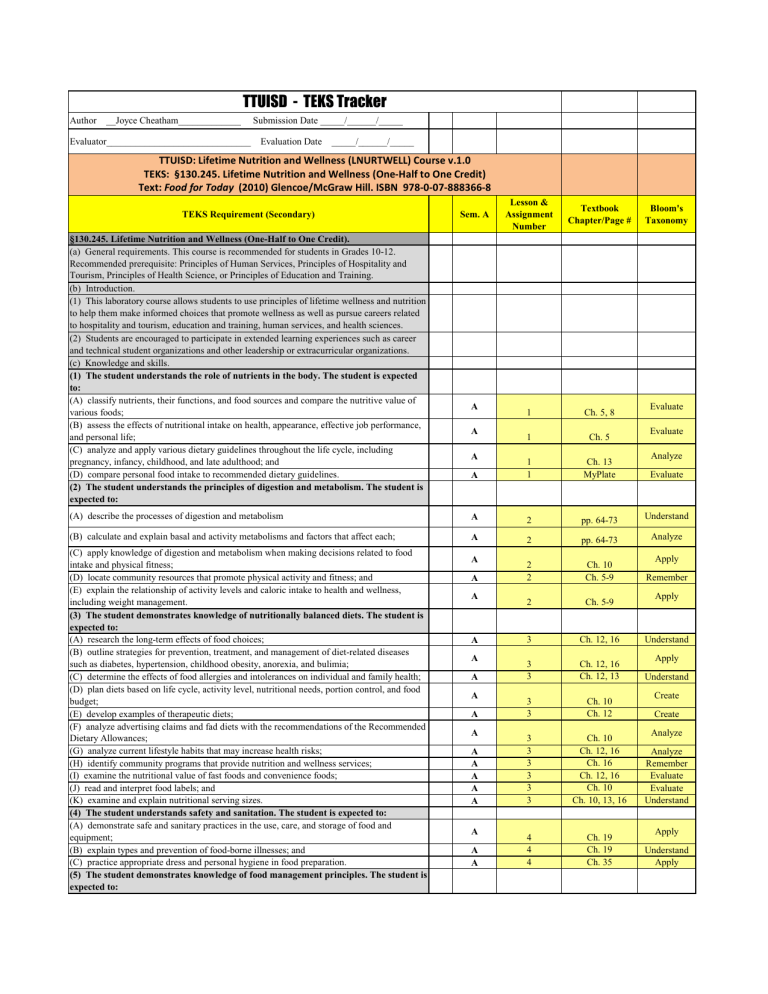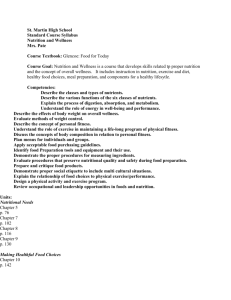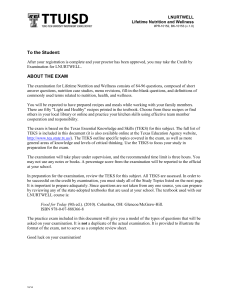Author __Joyce Cheatham_____________ ... Evaluator______________________________ Evaluation Date _____/______/_____

TTUISD - TEKS Tracker
Author __Joyce Cheatham_____________ Submission Date _____/______/_____
Evaluator______________________________ Evaluation Date _____/______/_____
TTUISD:
Lifetime
Nutrition
and
Wellness
(LNURTWELL)
Course
v.1.0
TEKS:
§130.245.
Lifetime
Nutrition
and
Wellness
(One
‐
Half
to
One
Credit)
Text:
Food
for
Today
(2010)
Glencoe/McGraw
Hill.
ISBN
978
‐
0
‐
07
‐
888366
‐
8
TEKS Requirement (Secondary) Sem. A
Lesson &
Assignment
Number
Textbook
Chapter/Page #
Bloom's
Taxonomy
§130.245. Lifetime Nutrition and Wellness (One-Half to One Credit).
(a) General requirements. This course is recommended for students in Grades 10-12.
Recommended prerequisite: Principles of Human Services, Principles of Hospitality and
Tourism, Principles of Health Science, or Principles of Education and Training.
(b) Introduction.
(1) This laboratory course allows students to use principles of lifetime wellness and nutrition to help them make informed choices that promote wellness as well as pursue careers related to hospitality and tourism, education and training, human services, and health sciences.
(2) Students are encouraged to participate in extended learning experiences such as career and technical student organizations and other leadership or extracurricular organizations.
(c) Knowledge and skills.
(1) The student understands the role of nutrients in the body. The student is expected to:
(A) classify nutrients, their functions, and food sources and compare the nutritive value of various foods;
(B) assess the effects of nutritional intake on health, appearance, effective job performance, and personal life;
(C) analyze and apply various dietary guidelines throughout the life cycle, including pregnancy, infancy, childhood, and late adulthood; and
(D) compare personal food intake to recommended dietary guidelines.
(2) The student understands the principles of digestion and metabolism. The student is expected to:
(A) describe the processes of digestion and metabolism
(B) calculate and explain basal and activity metabolisms and factors that affect each;
(C) apply knowledge of digestion and metabolism when making decisions related to food intake and physical fitness;
(D) locate community resources that promote physical activity and fitness; and
(E) explain the relationship of activity levels and caloric intake to health and wellness, including weight management.
(3) The student demonstrates knowledge of nutritionally balanced diets. The student is expected to:
(A) research the long-term effects of food choices;
(B) outline strategies for prevention, treatment, and management of diet-related diseases such as diabetes, hypertension, childhood obesity, anorexia, and bulimia;
(C) determine the effects of food allergies and intolerances on individual and family health;
(D) plan diets based on life cycle, activity level, nutritional needs, portion control, and food budget;
(E) develop examples of therapeutic diets;
(F) analyze advertising claims and fad diets with the recommendations of the Recommended
Dietary Allowances;
(G) analyze current lifestyle habits that may increase health risks;
(H) identify community programs that provide nutrition and wellness services;
(I) examine the nutritional value of fast foods and convenience foods;
(J) read and interpret food labels; and
(K) examine and explain nutritional serving sizes.
(4) The student understands safety and sanitation. The student is expected to:
(A) demonstrate safe and sanitary practices in the use, care, and storage of food and equipment;
(B) explain types and prevention of food-borne illnesses; and
(C) practice appropriate dress and personal hygiene in food preparation.
(5) The student demonstrates knowledge of food management principles. The student is expected to:
A
A
A
A
A
A
A
A
A
A
A
A
A
A
A
A
A
A
A
A
A
A
A
1
1
3
3
3
3
3
3
3
3
3
3
3
2
2
2
2
2
4
4
4
1
1
Ch. 5, 8
Ch. 5
Ch. 13
MyPlate pp. 64-73 pp. 64-73
Ch. 10
Ch. 5-9
Ch. 5-9
Ch. 12, 16
Ch. 12, 16
Ch. 12, 13
Ch. 10
Ch. 12
Ch. 10
Ch. 12, 16
Ch. 16
Ch. 12, 16
Ch. 10
Ch. 10, 13, 16
Ch. 19
Ch. 19
Ch. 35
Evaluate
Evaluate
Analyze
Evaluate
Understand
Analyze
Apply
Remember
Apply
Understand
Apply
Understand
Create
Create
Analyze
Analyze
Remember
Evaluate
Evaluate
Understand
Apply
Understand
Apply
TEKS Requirement (Secondary)
(A) read and comprehend standard recipes;
(B) correctly use standard measuring techniques and equipment;
(C) demonstrate correct food preparation techniques, including nutrient retention;
(D) use food buying strategies such as calculating food costs, planning food budgets, and creating grocery lists;
(E) demonstrate food preparation techniques to reduce overall fat and calories;
(F) practice etiquette, food presentation, and table service appropriate for specific situations; and
(G) apply food storage principles.
(6) The student demonstrates effective work habits. The student is expected to:
(A) participate as an effective team member demonstrating cooperation and responsibility;
(B) apply effective practices for managing time and energy to complete tasks on time; and
(C) practice problem solving using leadership and teamwork skills.
(7) The student investigates careers in nutrition. The student is expected to:
(A) compare and contrast education or training needed for careers in nutrition;
(B) establish personal short-term and long-term career goals; and
(C) analyze entrepreneurial opportunities in nutrition.
Source: The provisions of this §130.245 adopted to be effective August 23, 2010, 34 TexReg
5929.
Sem. A
A
A
A
A
A
A
A
Lesson &
Assignment
Number
5
5
5
Textbook
Chapter/Page #
Ch. 23
Ch. 23
Ch. 17, 18, 19, 41
Bloom's
Taxonomy
Understand
Apply
Apply
Apply
5 Ch. 17, 18, 19, 41
Apply
5 Ch. 17, 18, 19, 41
5
5
Ch. 18
Ch. 23
Apply
Apply
A
A
A
A
A
A
7
7
7
6
6
6
Ch. 18, 34
Ch. 4, 20, 21, 22
Ch. 18, 34 pp. 346, 397, 489
Ch. 1
Ch. 1
Apply
Apply
Apply
Analyze
Create
Apply





